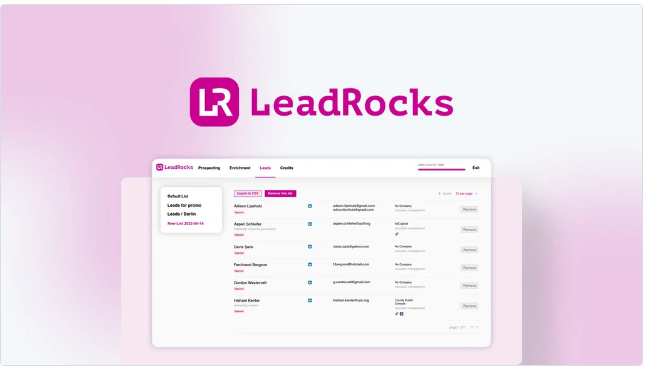Types of Lead Generation Better Examples
Every successful business understands that leads are essential for growth.
Whether you’re in the early stages of building a startup or running an established enterprise,
leads drive sales, create opportunities for customer retention,
and help scale the business.
However, generating high-quality leads requires
knowing which type of lead generation method will be
the most effective for your audience.
Lead generation strategies have evolved in today’s digital world,
and staying up-to-date with the most current practices is important.
The good news is that there are numerous approaches—each with strengths and best-fit scenarios.
This article explores types of lead generation,
highlighting both digital and traditional methods you can leverage
to build a steady stream of potential customers for your business.
What is Lead Generation?

Lead generation refers to attracting and converting strangers
or prospects into individuals who have expressed interest in your product or service.
Potential customers can be engaged through various channels,
such as websites, social media, email,
traditional cold calls or in-person networking.
Lead generation doesn’t stop at acquiring contact information—it also involves
building relationships that encourage
these leads to become paying customers over time.
Why is Lead Generation Important for Businesses?
In the competitive business landscape,
lead generation ensures a steady influx of potential customers who can eventually become loyal buyers.
Without a structured lead generation strategy,
you risk falling behind your competitors actively pursuing and engaging new prospects.
Generating leads gives businesses insight into their target audience,
allowing for more refined marketing tactics and better resource allocation.
Effective lead generation does more than just drive sales—it also plays a crucial role in:
Increasing brand awareness: The more people are exposed to your content and messaging,
the more likely they will recognize and trust your brand.
Building relationships: Lead generation allows you to nurture your prospects over time,
creating solid relationships that can lead to long-term loyalty.
Boosting conversion rates: The more leads you generate,
the higher the chances of turning them into paying customers.
Types of Lead Generation
There are several lead generation strategies,
each catering to different aspects of marketing,
audience types, and sales goals.
Lead generation can generally be divided into inbound and outbound,
as well as online and offline methods.
Inbound Lead Generation
Inbound lead generation focuses on attracting potential customers to you.
The idea here is to create valuable,
engaging content that draws prospects in naturally.
These are warm leads, meaning they’ve already shown interest
in what your business offers.
Content Marketing
One of the most popular methods in inbound marketing is content marketing.
This approach involves creating valuable content,
such as blog posts, videos, case studies,
and infographics, that answer your audience’s questions or solve their problems.
For example, if you run a web development company,
you might publish blogs or create tutorials about website maintenance,
WordPress tips or performance optimization strategies.
As prospects read and engage with your content,
they will likely fill out a form, sign up for a newsletter,
or request more information, turning them into leads.
SEO (Search Engine Optimization)
Search Engine Optimization (SEO) goes hand-in-hand with content marketing.
It involves optimizing your website and content to rank higher in search engine results pages (SERPs).

The higher your content ranks,
the more traffic it generates,
which leads to more opportunities for capturing leads.
SEO also includes keyword research,
link building, and on-page optimizations that ensure your content reaches the right audience.
When potential customers search for solutions related to your industry,
SEO helps make sure your business shows up as a trusted source.
Social Media Marketing
Social media has transformed into a dynamic lead-generation tool.
Platforms like Facebook, LinkedIn, Instagram, and Twitter
offer the perfect blend of organic and paid marketing opportunities.
You can engage with your audience through regular posts, stories,
or ads and direct them to your website or landing page, where
they can convert into leads.
For example, LinkedIn is a fantastic platform for B2B lead generation,
while Instagram can help B2C businesses thrive through visual storytelling.
Social media marketing allows you to meet prospects where they already are,
giving you an opportunity to build relationships in a more relaxed,
interactive environment.
Outbound Lead Generation
Outbound lead generation is a more proactive approach.
It involves reaching out to potential leads directly,
often through more traditional methods.
While this approach might seem more intrusive,
it’s effective, especially for B2B industries.
Cold Calling
Cold calling is one of the most direct outbound methods.
It involves calling potential leads who haven’t expressed prior interest in your product or service.
Though it may seem outdated,
cold calling remains effective in industries where direct contact is crucial,
such as real estate, B2B, and financial services.
The key to cold calling is providing value from the get-go.
You must quickly engage the prospect and explain why your offering could benefit them.
This approach requires skillful communication, persistence, and patience.
Email Outreach
Email outreach is another effective outbound strategy
that involves sending personalized or automated emails to potential leads.
This method works well in nurturing leads
who have already interacted with your business
or expressed interest in similar products or services.
Personalized email campaigns,
tailored to the needs of your audience,
tend to perform better than generic email blasts.
Emails that offer relevant solutions or address a specific pain point are more likely to convert.
Direct Mail Campaigns
Though not as commonly used today,
direct mail still has its place in outbound lead generation.
A well-crafted postcard, flyer, or letter can make a lasting impression,
especially with digital efforts like personalized URLs (PURLs)
or QR codes that direct recipients to online content.
Direct mail campaigns work well for local businesses,
high-ticket items, or niche industries where a more personal touch
can differentiate your brand from competitors.
Online Lead Generation

The internet has opened up countless opportunities for lead generation.
Here are some effective methods,
from paid advertising to webinars, to capture leads online.
Pay-Per-Click Advertising (PPC)
PPC advertising allows you to place ads on search engines or social media platforms.
You only pay when someone clicks on your ad.
Google Ads and Facebook Ads are prime examples of PPC campaigns
that can be fine-tuned to target specific audiences.
With PPC, businesses can drive immediate traffic to landing pages,
capturing leads as they click through and engage with the offer.
The success of PPC often depends on how well the ads are targeted,
the quality of the landing page, and the offer’s value.
Webinars and Virtual Events
Webinars and virtual events provide an excellent opportunity
to generate leads while showcasing your expertise.
Hosting an online event allows you to capture contact information from attendees while also providing them with valuable content,
such as a live presentation,
product demo, or expert panel discussion.
The interactive nature of webinars helps build trust,
making attendees more likely to convert into leads.
Lead Magnets (eBooks, Whitepapers)
Lead magnets are gated content—valuable resources offered in exchange for contact information.
For instance, eBooks, whitepapers, checklists,
and templates are popular lead magnets.
They provide helpful insights or tools,
making it worth a prospect’s time to share their email address in return for access.
The key to effective lead magnets is ensuring
the content is high-quality and directly relevant to your audience’s needs.
Offline Lead Generation
While the digital landscape dominates lead generation,
offline methods are valuable,
especially for building personal connections and networking in your industry.
Networking Events
Networking events, whether they are local meetups,
industry conferences, or chamber of commerce gatherings,
provide an opportunity to engage with potential leads in person.
These events allow you to establish personal connections,
exchange business cards,
and begin relationships that can become long-term business opportunities.
Trade Shows
Trade shows and expos allow businesses to showcase
their products or services to a highly relevant audience.
Setting up a booth or giving a live demo lets you engage directly with prospects,
answer their questions, and collect their contact information.
This lead generation form is especially effective for B2B companies that sell to niche markets.
Direct Sales
Direct sales, whether in the form of door-to-door interactions,
field marketing, or in-store sales,
allow businesses to engage with prospects on a personal level.
Businesses can build trust and relationships
that lead to conversions by interacting face-to-face.
Best Practices for Effective Lead Generation
Regardless of which method you choose,
several best practices can help ensure the success of your lead generation efforts.
Creating a Compelling Offer
Your offer will entice potential leads to share their contact information.
Whether it’s a discount, free consultation,
exclusive webinar, or downloadable resource, your offer should provide real value.
Remember, the more compelling the offer,
the more likely you are to generate high-quality leads.
Building a Strong Landing Page
A well-optimized landing page is critical to converting traffic into leads.
Your landing page should be clean,
focused, and easy to navigate.
The headline should be clear, the offer should be enticing,
and the call-to-action (CTA) should stand out.
Making the lead capture form as simple as possible is also important.
Ask for only the necessary information—like name and email address—so prospects don’t feel overwhelmed.
Optimizing Your Lead Funnel
The lead generation funnel represents the customer journey from awareness to conversion.
To maximize conversions, optimize each stage of your funnel.
This might include targeted email sequences,
retargeting ads, or content that nurtures leads as
they move closer to making a purchase decision.
Conclusion
Lead generation is an essential component of a successful marketing and sales strategy.
Whether you’re relying on inbound methods like content marketing and SEO,
outbound tactics like cold calling and email outreach, or a mix of online and offline strategies,
the goal remains the same—capturing high-quality leads likely to convert into paying customers.
By understanding the different types of lead generation and how to implement them effectively,
businesses can drive steady growth and foster lasting relationships with their customers.
Remember, it’s not just about collecting leads—it’s about nurturing them into long-term,
loyal clients who will return.
FAQs
What is the difference between inbound and outbound lead generation?
Inbound lead generation focuses on attracting prospects to you through valuable content and organic interactions,
while outbound lead generation involves actively
reaching out to potential customers through direct methods like cold calls or email outreach.
Can small businesses benefit from lead generation strategies?
Absolutely! Small businesses can tailor lead generation strategies to their specific needs and budgets.
Inbound strategies like content marketing and SEO can attract high-quality leads even with limited resources.
What tools can help automate lead generation?
Several tools, such as HubSpot, Mailchimp, and Salesforce,
are designed to streamline the lead generation process.
These tools can help with email marketing,
customer relationship management (CRM), and lead nurturing.
How can I measure the effectiveness of my lead generation strategy?
Track metrics like conversion rates, cost per lead,
and customer acquisition cost (CAC) to measure your lead generation success.
You can also analyze traffic sources, engagement rates,
and lead quality to determine the performance of specific channels.
How can social media help with lead generation?
Social media allows you to engage with your audience through organic posts and paid advertising.
Platforms like Facebook and LinkedIn offer targeted ad campaigns that can direct traffic to lead capture forms,
webinars, or landing pages.







